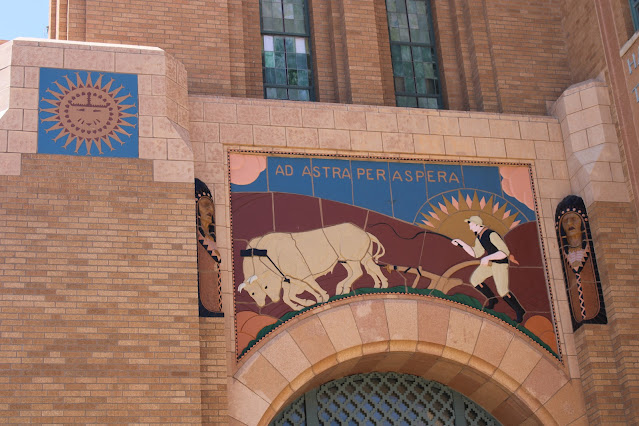I put together a previous blog post about the Art Deco design exhibit at the Wichita Art Museum. That blog post can be found here:
That led to a friend of ours sending me a link to a YouTube video dealing with the numbers of Art Deco buildings to be found in and around Wichita. That video presentation can be found here:
The presentation lists addresses so we soon found ourselves on a field trip photographing various buildings of architectural interest.
This first building is a comfort station in one of Wichita's city parks along the river. It is a small building with great detail and brickwork as well as clerestory windows that provide natural light inside the bathrooms.
 |
| Wonderful detailing of the window, brickwork and decorative frieze |
 |
| The same decorative accents can be found inside the bathroom area |
 |
| Natural lighting from the clerestory floods the interior |
 |
| Overhead clerestory view |
 |
| Decorative brickwork on the exterior |
The North High School is a particularly impressive Art Deco design

 |
| These figureheads were done using a material known as Carthalite |
Barbara Hammond, planning analyst for the Wichita Historic Preservation Office, wrote an article for American Bungalow detailing the history of Carthalite
Hammond began searching for Carthalite in Wichita last year when writing a historical-places proposal for the former pharmacy at Central and Grove. When she learned that the building had Carthalite in it, she started investigating what Carthalite meant and where it was located.
Here’s what she found:
When the Cement Stone & Supply Co. went into business in 1905 in Wichita, it manufactured molded architectural elements of natural gray or white concrete and called the products Carthalite to differentiate them from similar ones made by other companies.
In the mid-1920s, the company (the precursor to today’s Lusco Brick & Stone Co.) devised a method of incorporating brightly colored Carthalite motifs within a background of gray or white as decorative trim on an assortment of buildings in Wichita.
Carthalite incorporates particles of sand, crushed rock and/or crushed glass into cement with mineral pigments.
From a distance, it looks like the glazed terra cotta that you would see on structures such as the Petroleum Building, 221 S. Broadway, but that is only colored on the surface, like paint, Hammond said.
Architectural innovation
Many of the Carthalite designs are geometric in form, typical of 1920s Art Deco style; others are curvilinear designs with wavelike forms; and still others follow the smooth streamlining of Art Moderne styling. Finally, in contrast to those repeating patterns, the mural on the Airport Administration Building (now the Kansas Aviation Museum) is a free-form bas-relief sculpture.
“It is a remarkable example of an indigenous and historic architectural innovation of surprising, and surprisingly simple, beauty that, according to some architectural historians, may be unique to the U.S. – and to Wichita,” Hammond wrote in American Bungalow.
 |
| These are wonderful examples of the use of Carthalite |
Art Deco design was not just limited to buildings but also embraced bridges such as the John Mack bridge on South Broadway in Wichita.
Built in 1931, the 800-foot span bridge of reinforced concrete consists of eight tied arches and was named after John Mack of Newton who, as a member of the state highway commission, was known as the "father of good Kansas roads." The Marsh Arch in Fort Morgan, Colorado has eleven arches.
The best description of Marsh's bridge design is contained in his 1911 patent application: The bridge consisted of "two abutments, a pair of arches disposed between and spring from the abutments, the floor carried by and between the arches and reaching from one abutment to the other where it aligns with the parapets or rails along opposite sides of the floor line." Slideable wear plates were molded into the concrete where the bridge floor came into contact with the beams and abutments. Later refinements made use of the cast steel expansion rocker bearing. One of the main benefits of the design was to allow for the expansion and contraction of the reinforced concrete bridge under varying conditions of temperature and moisture.
In 1991 the John Mack Bridge was in danger of being torn down but a community effort saved the bridge. It was placed on the National Register in 1992 and was renovated in 1997. A new low profile bridge was built immediately on its east side to provide for four-lane traffic flow along Broadway. This was hailed as a great success for historic preservation in Wichita.




























No comments:
Post a Comment